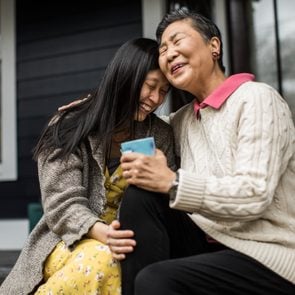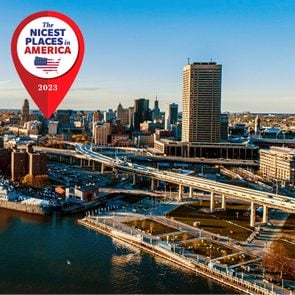Provo, Utah's third-largest city, built a blueprint to help combat disproportionately high suicide rates in young people in the western United States. Its cornerstones? Prevention and hope.
Plagued by a Youth Suicide Epidemic, Provo, Utah, Worked Together to Find a Remedy—and Became 2024’s Nicest Place in America

In 2020, when Sara “Seung” Blanco Parra was 12, she and her family left their home in Colombia and wound up in Provo, Utah. It couldn’t have been more obvious that they were outsiders. They were immigrants, spoke little English and practiced Catholicism in a city whose population mostly belongs to the Church of Jesus Christ of Latter-day Saints (LDS). And yet Blanco Parra, now 16, says she’s never felt more safe or welcome.
“In Colombia,” she says, “I hardly knew my neighbors. Here, I know I could ask anyone for help, and they would give it to me.”
During their first few months in Provo when the family had no car, Blanco Parra remembers a motorist pulling over as she was walking to a restaurant with her mother. He gave them a lift, paid for their meal and then hurried off.
This was Provo.
It was the living embodiment of Mormon culture—conservative while curious and open to the world, entrepreneurial while charity-minded, abstemious while fun-loving, ambitious while family-oriented. The city frequently made it onto lists for great places to live, to work, to raise a family and to play in the outdoors. When one local family was entertaining friends from out of town, the guests looked around and commented, “This place feels like Mayberry.”
There are plenty of reasons that this beautiful city of 113,000 like-minded neighbors could’ve been named the Nicest Place in America. But Provo also struggled with a dark secret. Starting in the late 1990s, young people had begun killing themselves at an alarming rate. What sets the community apart is the blueprint it built to fight this deadly epidemic.
Get Reader’s Digest’s Read Up newsletter for more inspiring stories, humor, cleaning, travel, tech and fun facts all week long.
Understanding the root of the problem
In 1999, a 14-year-old boy walked into Provo High School, the city’s second-largest school, and handed his watch to his best friend.
“I’m not going to need this after tomorrow,” he said. During the school day, he shared his plans with six other friends, then went home and killed himself. He wasn’t the first.
In the early 2000s, sociologists identified a “suicide belt” stretching across the Intermountain West from New Mexico to Montana. Suicide rates within the belt were about twice the national average, and Provo wasn’t immune. Between 1998 and 2003, the Provo City School District averaged one or two suicides per year. Over a three-year period, its largest school, Timpview High School, suffered four deaths among its population of 2,100 students.
Why was this happening? Could the conformism and strictures of the Mormon church, with its moral prohibitions, be suffocating for young people? Conversely, could life for nonmembers in Provo be challenging? But the cases didn’t neatly align with the first theory, and research suggests that religion can be protective against suicide.

It was when Greg Hudnall, the associate superintendent with the Provo City School District, actually sat down with young people who had attempted suicide that things came into focus. He consistently heard them describe a sense of loneliness, of isolation, of anonymity.
“Do you have any idea what it’s like,” one girl said to him after her suicide attempt, “to attend a middle school with 1,200 students, share a locker, play on the volleyball team and not once in three weeks hear your name mentioned?”
Somehow, in this city famous for its niceness, too many kids were feeling as if they didn’t matter. Whatever was driving that, the solution began to appear clear: Make sure the kids knew they did matter. But how?
Finding hope—and a solution
When Hudnall, now 66, began exploring youth-focused prevention programs at other school districts, he learned that many administrators handpicked their most popular students to be trained on what to do if a classmate appeared suicidal. In 2004, Hudnall, along with the school system’s prevention officer, Cathy Bledsoe, took a slightly different tack: Rather than identifying the popular kids themselves, they asked every student at Timpview to name three classmates—not kids who were popular, but those they would turn to if they were in crisis. Out of 2,100 students, 40 names rose to the top. They came from all over the student body—athletes, nerds, drama kids, cowboys, gay, straight, LDS, non-LDS—but they shared a set of traits. They were known among their classmates to be good listeners, caring people, empaths.
Hudnall and Bledsoe, now 72, rounded them up to talk about suicide prevention, and the kids gave themselves a name: the Hope Squad.
Working with local mental health experts, including Brigham Young University academics, Hudnall trained the Hope Squad members to recognize suicide warning signs, taught them what questions to ask and empowered them to guide their struggling classmates toward counselors and social workers. The Hope Squad wore special T-shirts to school, hosted a Hope Day and Hope Week, and met regularly for training and fellowship.
Things turned around so abruptly, it was startling. The year after the first Hope Squad was formed—after that devastating string of four suicides in three years—not a single Timpview student took their own life. Nor during the second year, nor the third, nor the fourth … nor, as of this year, the 20th. The program has been so successful that it was adopted in all 19 of the district’s schools, then approved by the Utah legislature as a recipient of funding for any school in the state wishing to start a Hope Squad.
Embracing Provo’s sense of community
Nestled between the majestic Wasatch Range of the Rocky Mountains and the high-altitude Utah Lake, Provo is a place of natural beauty. It was settled in the 1840s when, under the leadership of their prophet Brigham Young, pioneers belonging to the LDS Church trekked across the Great Plains. They settled Salt Lake City, then Provo, turning an inhospitable desert valley into a lush oasis. Their emblem, the beehive, symbolized their industriousness and unity.

They planted orchards, built wool and steel mills, and established Brigham Young University (BYU), which is home to some 35,000 students. Today, the city is quite diverse, with Spanish-speaking wards, Pacific Islander wards and Korean wards. In recent decades, Provo has given rise to health-care, finance and tech companies, and its prosperous, enterprising culture is the perfect extension of its bustling-beehive past. It enjoys affordable housing, an enviably low crime rate and a high rate of community volunteerism.
“We know our neighbor. We’re kind. We look out for each other,” says the city’s mayor, Michelle Kaufusi. “Provo people are sensitive to what’s going on in the community.”
On any given Saturday, some 250 volunteers show up, ready to work, in a preselected neighborhood. They will rip out damaged trees, pour concrete for driveways, “anything we can do to help the neighbors,” says Kaufusi, 57. The Provo native, who grew up as one of seven kids in a single-parent household, started this MyHometown initiative to help the city that helped raise her.
Residents of Provo are also notoriously outdoorsy, hiking Provo Canyon, fishing Utah Lake, skiing at Sundance. The city boasts a center for the arts, four science museums, a picturesque public library, several theaters, a state-of-the-art rec center, ice cream shops that outnumber bars 15 to 1, and an LDS meetinghouse on nearly every corner.
While life in an LDS town can have its challenges for nonmembers, there’s surprisingly little conflict. As Trenton Brown, a 32-year-old non-LDS transplant from upstate New York, puts it, “You never feel judged. It really is a great place to live.”
Saving thousands of lives around the country
Hudnall retired from the school district and now operates Hope Squad as a nonprofit in Utah. In 2017, he began licensing the program to schools around the country. There are Hope Squads in 2,000 elementary, middle and high schools, a few colleges, a few corporations and even some senior centers. To date, the program has resulted in 12,000 referrals to mental health services and more than 2,500 hospitalizations.
Blanco Parra is now a Hope Squad member, as were all six of Kaufusi’s kids. Blanco Parra recently became friends with a girl in the nearby town of Spanish Fork. In early 2024, she noticed that her new friend’s text messages contained an alarming litany of daily pressures, conflicts with parents, expressions of hopelessness. She kept thanking Blanco Parra for being her friend and left three or four tearful audio messages.
Although the girl lived in another school district, Blanco Parra contacted a Timpview counselor and together they connected her friend with a school social worker, who helped her through the crisis.
“She was a little angry that I did that,” says Blanco Parra. “But at the same time, she was glad.”
Helping in little ways that make a big difference
Such dramatic cases are relatively rare. Hope Squads would not be nearly so successful if members only stepped in to help after their peers were already in crisis. Instead, a Hope Squad is about the crucial yet less glamorous work of deep prevention, of making all their classmates feel seen so that they never begin thinking about taking their own lives.
Hope Sybrowsky, 16, the aptly named president of Timpview’s Hope Squad, describes the bulk of the work as “going to school every day and looking around. You might see someone happy and bubbly one day and then the next day they’re sort of quieter. So I will just go up to them and say, ‘Hey, are you doing OK? Because it looks like you’re feeling a little down.’ ”
Some Hope Squads will sit together and memorize the names and faces of everybody in their school. Having someone drop a casual, “Hey, Megan!” in the hallway can feel like a gift. Not all Hope Squad members are naturally extroverted, but belonging to the organization gives them license to act on their benevolent instincts.
School counselor Rachelle Carter, 54, who is the adviser to Timpview’s current Hope Squad, marvels at how uninhibited the group’s members can be.

“I can’t tell you how many times I have seen them go up and just sit with someone that was all by themselves,” she says. “Just sit there and eat lunch with them or just talk to them. They’re the type of kids who are not afraid to do that. They want to just watch out for people.”
To be clear, Hope Squad members aren’t expected to be counselors. Rather, they’re taught to be sensitive to the struggles of their peers and to bring in adult help when they see red flags, as was the case with Blanco Parra and her Spanish Fork friend. Momi Tu’ua, 57, Timpview’s current principal, estimates that in her school alone, there have been about 100 referrals made by Hope Squad members over the years.
“About a third of them were cases where we had to intervene at a much deeper level,” she says. “I shudder to think what would have happened in those 30 or so cases without the Hope Squad.”
Continuing to reach out and connect
Adam McMurray, 18, is a former Hope Squad member and a freshman at BYU who plans to establish the university’s first Hope Squad.
During high school, he says, “it can feel like all your peers are finding their place—the football team, math club. A few students just don’t seem to quite fit in anywhere. Everyone in Hope Squad was on the lookout for those people. It trained us to have those eyes to see those other students.”
Acknowledging the worth of the people around you, McMurray says, “is something I think everyone in the world could do a little bit better on.”

Of course, Provo is not perfect. Ensuring that everyone feels included is an ongoing challenge, says Hudnall: “You really have to work at it. It’s not one and done.” But he’s confident his city will continue to put in the effort. Provo’s key asset, Hudnall believes, is “stalwart, kind, supportive people, who really care about connection.”
Kaufusi has a message for every person who calls Provo home: “We want them to know that we need them. We need them in our families, we need them in our communities, in our schools, in our friend groups. They are loved and needed.”
Why trust us
For more than 100 years, Reader’s Digest has been known for its heartwarming true stories and focus on community. In 2016, we launched the Nicest Places in America, an annual contest that honors kind, inspiring people making a difference in their hometowns. Readers send in nominations, and Reader’s Digest’s editorial team vets the entries and whittles them down with the help of a panel of judges. This year, the judges included Today’s Al Roker, Tuesdays with Morrie author Mitch Albom, author and podcast host Mónica Guzmán, award-winning journalist and author Steve Petrow, Reader’s Digest CEO Bonnie Kintzer, and Craig Elston, a barber who helped Buffalo, New York, earn the title of Nicest Place in America in 2023. We are committed to producing high-quality content by writers with expertise and experience in their field in consultation with relevant, qualified experts. Read more about our team, our contributors and our editorial policies.


